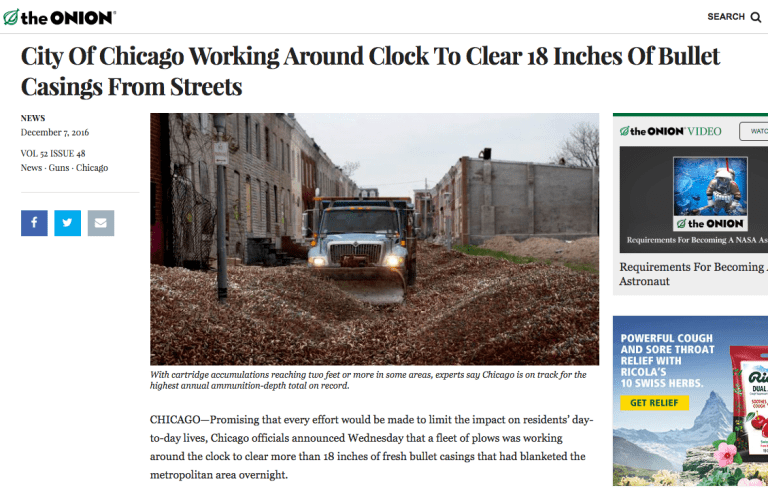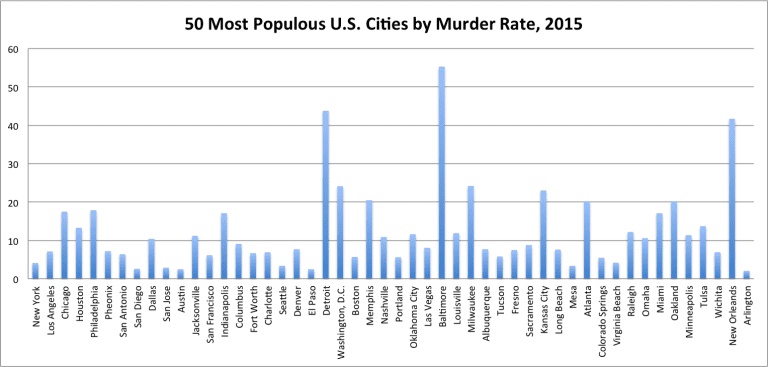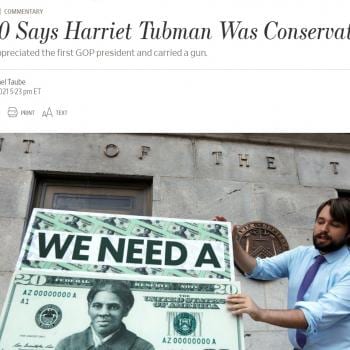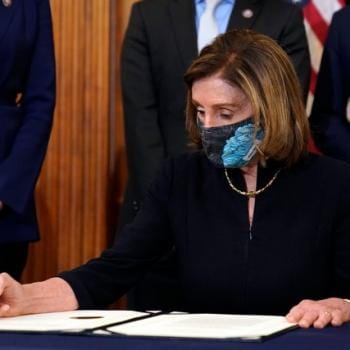Chicago came up quite a lot during this year’s presidential election. Donald Trump came back to the city repeatedly in his speeches and debate performances, using it as the ultimate illustration of the need for “law and order” and a police force that is touch on crime. Have a look at this quote from his first debate:
We have a situation where we have our inner cities, African- Americans, Hispanics are living in hell because it’s so dangerous. You walk down the street, you get shot.
In Chicago, they’ve had thousands of shootings, thousands since January 1st. Thousands of shootings. And I’m saying, where is this? Is this a war-torn country? What are we doing? And we have to stop the violence. We have to bring back law and order.
Trump isn’t the only one talking about Chicago; the city has been the center of much media buzz given its higher than average number of homicides this year. Even the Onion has poked fun at the tenor of public discussion surrounding the city:

I have to admit, I initially bought into some of this rhetoric. Oh, I knew Chicago wasn’t the war-torn post-apocalyptic wasteland Trump’s rhetoric would suggest. I knew that in any city crime rates very widely by city neighborhood; that in any large city crime tends to occur within specific networks rather than wantonly; and that crime rates are way down from the 1990s. Still, I had heard Chicago referred to as the “murder capital” of the U.S., and I thought it was. I turns out it’s not.
Each year, the FBI releases crime statistics. It is possible to use this data to rank cities by their murder rate, though the FBI warns against taking such comparisons too far, cautioning that murder rates vary depending on a large number of factors. Last year, CBS News analyzed the FBI’s data for 2015 to find the ten cities with the highest violent crime rates, out of all cities with populations of over 250,000 people.
Here is their list:
Detroit, Michigan 1988.63
Memphis, Tennessee 1740.51
Oakland, California 1685.39
St. Louis, Missouri 1678.73
Milwaukee, Wisconsin 1476.41
Baltimore, Maryland 1338.54
Cleveland, Ohio 1334.35
Stockton, California 1331.47
Indianapolis, Indiana 1254.66
Kansas City, Missouri 1251.45
Chicago is not on the list. Okay, but what about murder rates? CBS News also analyzed murder data, releasing this top ten list:
St. Louis, Missouri 49.91
Detroit, Michigan 43.52
New Orleans, Louisiana 38.75
Baltimore, Maryland 33.84
Newark, New Jersey 33.32
Buffalo, New York 23.22
Pittsburgh, Pennsylvania 22.43
Memphis, Tennessee 21.38
Atlanta, Georgia 20.47
Cincinati, Ohio 20.16
Chicago is, again, not on this list.
Of course, that’s for 2014. What about 2015? I looked up the data, which was released in September. I calculated the murder rate in each of the 50 most populous cities. Here is a quick graph:

No, that tall bar near the center is not Chicago. It’s Baltimore. The other two tall bars aren’t Chicago either—they’re Detroit and New Orleans. Chicago is the third bar from the left. Yes, it’s still high compared to many of the other cities listed. It tops off at 17.5 murders per 100,000. In contrast, over half of the cities shown in the graph (27 out of 50) don’t top the 10 murders per 100,000 line. However, nine of these cities (Detroit, Washington, D.C., Memphis, Baltimore, Milwaukee, Kansas City, Atlanta, Oakland, and New Orleans) top the 20 murders per 100,000 line, and Chicago is not in the top ten cities with the highest murder rates.
And this list only includes the fifty most populous cities. If you expand the list to, say, all cities over 100,000, the number of cities with murder rates over 20 or 30 per 100,000 people soars. Hartford, Connecticut. Jackson, Mississippi. Cincinnati, Ohio. If we expanded the list to cities of 25,000 or more, we’d need to include Chester, Pennsylvania, Pine Bluff, Arkansas, and Buffalo, New York.
Yes, Chicago’s murder rate promises to be higher in 2016 than it was in 2015. Given the current number of murders in the city so far this year, its murder rate is likely to be around 27 per 100,000. This increase is concerning and will bump Chicago up the list quite a bit. People are talking about Chicago both because the city’s murder rate is spiking (from 15.1 in 2014 to 17.5 in 2015 to 27 in 2016) and because Chicago is often classed together with LA and NYC as the three largest cities in the country, and those two cities have far lower murder rates—LA and NYC have murder rates of 7.1 and 4.1.
Have a look at these two graphs:


There are two points to be made here. First, the number of homicides in Chicago this year (744 as of December 14th) is still below the high numbers of the mid-1990s. This year’s total is bad, and the rise in numbers a problem, but Chicago has seen worse. Second, New York City and Los Angeles have successfully brought their homicide rates down and kept them down since a similar peak in the mid-1990s. What, then, is different about Chicago? Why is its murder rate on the rise while NYC and LA, the two cities it is most often grouped with, have maintained their far lower numbers?
As it turns out, there are reasons for Chicago’s rising murder rate, reasons specific to Chicago. Individuals who study crime in general and Chicago in particular have been pointing to these reasons for some time now. Unfortunately, on the national level, “We need law and order!” seems to play better than “Chicago’s gangs have fragmented, leading to increasing levels of gang warfare in highly segregated economical depressed areas of the city, a situation compounded by easy access to guns from Indiana, which borders the city.” And that is a problem.
However. Even with its rising murder rate, statistics from cities across the country make clear that Chicago is not the country’s “murder capital.” In fact, cities like Detroit, Baltimore, and New Orleans had 2015 murder rates nearly twice Chicago’s likely 2016 murder rate, and it appears that Milwaukee and Kansas City will have similar 2016 murder rates to Chicago’s.
When was the last time you heard someone talking about gun violence in Atlanta, or Memphis, or Kansas City? What do we lose when we don’t talk about murder rates in cities like Detroit or Oakland? Taking the causes of Chicago’s rising murder rate seriously should not mean ignoring the causes of even higher murder rates in other cities. How can we make good decisions at the polls when our understanding of the problems at hand is so often piecemeal, incomplete, and filtered through a news media that cares more about titilating than it does about informing?
I worry that we as a people are chronically unable to focus on problems rather than on scapegoats, that we as humans with human brains are unable to properly assess dangers or analyze cause and affect. Solutions are rarely simple, and problems are rarely one-dimensional. It’s easier to think in terms of stereotypes and pithy slogans, but doing so is neither accurate nor helpful. What the solution is, I don’t know.
I have a Patreon! Please support my writing!














